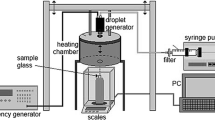Abstract.
This paper presents the results of an experimental investigation, into the effect of water in diesel and kerosene emulsions, on the evaporation time of a single droplet, on hot surfaces (stainless-steel and aluminum). Experiments are performed at atmospheric pressure, and initial water volume concentrations of 10, 20, 30, and 40%. The wall temperatures ranging from 100–460 °C, to cover the entire spectrum of heat transfer characteristics from evaporation to film boiling. Results show that, qualitatively, the shapes of emulsion evaporation curves are very similar to that of pure liquids. Quantitavely, there are significant differences. The total evaporation time, for the emulsion droplets is lower than that for diesel and kerosene fuels, and decreased as water initial concentration increases, up to surface temperatures less than the critical temperature. The value of the critical surface temperature (maximum heat transfer rate), decreases as initial concentration of water increases. In the film-boiling region, the evaporation time for the emulsion droplets is higher than for diesel and kerosene droplets, at identical conditions.





Similar content being viewed by others
Abbreviations
- hfg :
-
latent heat of vaporization, KJ/kg
- m:
-
mass of the droplet, gm
- Tb :
-
boiling temperature, °C
- Tc :
-
critical temperature, °C
- TL :
-
Leidenfrost temperature, °C
- Ts :
-
initial surface temperature of the hot surface, °C
References
Barnes A; Duncan D; Marshall J; Psaila A; Chadderton J; Eastlake A (2000) Evaluation of water-blend fuels in a city bus and an assessment of performance with emission control devices, better air quality motor vehicle control and technology workshop
Jae W; Huh KY; Park KH (2000) Experimental study on the combustion characteristics of emulsified diesel in a RCEM, FISITA World Automotive Congress
Sawa N; Kajitani S (1992) Physical properties of emulsion fuel (water/oil) and its effect on engine performance under transient operation, alternative fuels for C.I. and S.I. engines. SAE special publications, U.S.A. 97–107
Cho P; Law C; Mizomote M (1991) Effect of pressure on the micro-explosion of water/oil emulsion droplets over a hot plate. J Heat Transfer Transaction ASME 113: 272–274
Avedisian C; Fatehi M (1988) An experimental study of the Leidenfrost evaporation characteristics of emulsified liquid droplets. Int J Heat Mass Transfer 31: 1587–1603
Sheffield S; Baer M; Dension C (1981) Paper Nos. 42 and 43, Fall technical meeting, Eastern States Section of the Combustion Institute, New Jersey
Wang C (1983) Ph. D., Thesis, Northwestern University
Gengel Y; Turner R (2001) Fundamentals of thermal-fluid sciences. McGraw-Hill International edition New York: 934
Xiong T; Yuen M (1991) Evaporation of a liquid droplet on a hot surface. Int J Heat Mass Transfer 34: 1881–1894
Abu-Zaid M (1999) Effects of the momentum of water droplet on its evaporation on heated surfaces. Alexandria Eng J 38: A123–A133
Author information
Authors and Affiliations
Corresponding author
Rights and permissions
About this article
Cite this article
Abu-Zaid, M. An experimental study of the evaporation characteristics of emulsified liquid droplets. Heat and Mass Transfer 40, 737–741 (2004). https://doi.org/10.1007/s00231-003-0473-5
Received:
Published:
Issue Date:
DOI: https://doi.org/10.1007/s00231-003-0473-5



